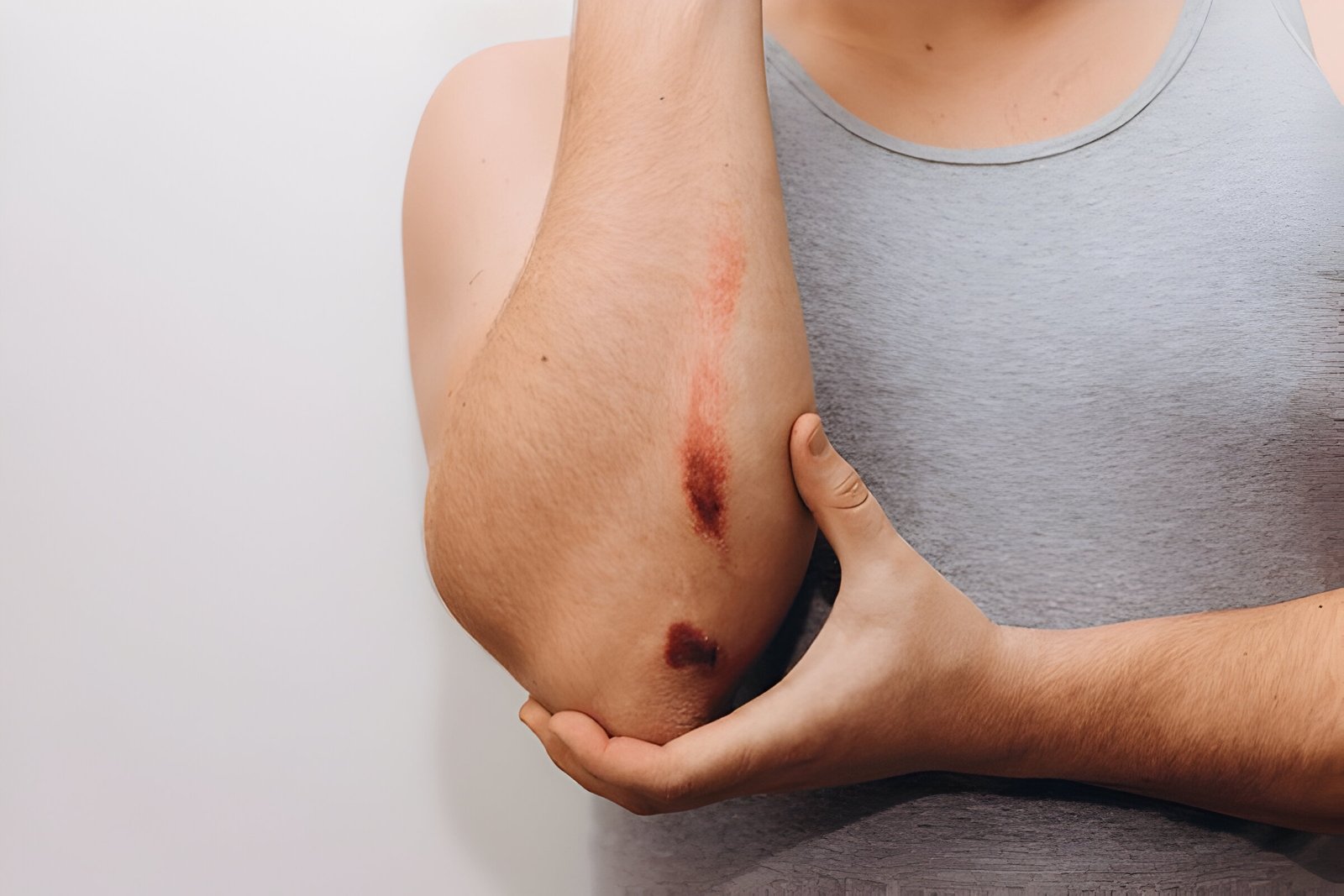Image Credit: Shutterstock Image
Eschar, a thick, dry scab formed on the skin during wound healing, presents a complex challenge in medical care. This distinctive tissue formation plays a crucial role in the recovery process but can also pose risks if not managed properly. Understanding eschar and its implications is essential for healthcare professionals and patients alike, as it impacts wound healing outcomes and overall patient well-being.
This article delves into the intricacies of eschar, exploring its formation, characteristics, and management strategies. It sheds light on the differences between eschar and slough, two commonly confused wound tissues. Additionally, it provides insights into effective treatment methods, including escharotic approaches and management. By examining these aspects, readers will gain valuable knowledge to identify and treat effectively, ultimately improving wound care practices and patient outcomes.
Also Read More: Toasted Skin Syndrome
Table of Contents
ToggleUnderstanding Eschar Formation
Eschar formation occurs when necrotic tissue develops in a wound. This devitalized tissue, typically dark brown or black, can appear as a natural shield but often hinders healing. Usually has a dry, thick texture, but it may also be soft, boggy, or fluctuant, especially in the presence of infection.
Stages of wound healing
Wound healing progresses through four stages:
- Stage 1: Unbroken skin with slight redness
- Stage 2: Open or broken skin, resembling a ruptured blister
- Stage 3: Deep, crater-like wound with yellow dead tissue
- Stage 4: Serious wound with exposed muscle, bone, or tendons
Factors contributing to eschar development
It develops due to decreased blood flow to an open wound. Pressure injuries commonly lead to formation, as unrelieved pressure causes poor skin perfusion. Once the skin loses its blood supply, tissue death occurs, resulting in wound formation.
Types of wounds prone to eschar
Pressure ulcers, arterial ulcers, and full-thickness burns are particularly prone to eschar development. Arterial ulcers often present with black eschar on distal toes and the malleolus. The heel of the foot is a common area formation due to mixed etiologies of pressure injury and poor arterial blood flow.
Click Here To Get Know About: What Is Imitation Crab Made Of
Eschar vs. Slough: Key Differences
Appearance and texture
Eschar presents as a dry, thick, black or brown covering over wounds, resulting from tissue necrosis and desiccation. It has a firm, leathery texture and adheres tightly to the underlying skin. Slough, in contrast, appears as a yellow or white, moist substance on the wound surface. It has a soft, gelatinous consistency and may be loosely attached to the wound.
Impact on wound healing
Both eschar and slough can impede the healing process. Eschar forms a protective barrier against infection but may hinder tissue regeneration. Slough, while offering some protection, can prevent the migration of healthy cells and increase the risk of infection if excessive. Proper management of both is crucial for effective wound care.
Effective Eschar Management
Assessment techniques
Visual inspection and palpation are crucial for assessing it. Healthcare professionals examine the extent, depth, texture, and adherence to underlying tissues. Diagnostic imaging may also be employed. It’s essential to differentiate between eschar and scabs, as they require different management approaches.
Treatment approaches
Treatment often involves debridement to remove necrotic tissue and facilitate healing. Methods include autolytic, enzymatic, mechanical, and surgical debridement. Topical antimicrobial agents and dressings promoting autolytic debridement are also used. For exudative wounds, moisture-controlling dressings like alginates and hydrocolloids are beneficial. Negative pressure wound therapy can enhance healing by improving capillary perfusion and wound contraction.
Prevention strategies
Prevention focuses on early and aggressive burn wound management, prompt eschar removal, and appropriate dressing use. Strategies include frequent repositioning, pressure-relieving surfaces, adequate nutrition, hydration, and managing underlying conditions like diabetes. Maintaining clean, dry skin and addressing incontinence promptly are crucial for preventing eschar formation.
Read More About: Star Anise Benefits
Conclusion
The management of eschar has a significant impact on wound healing outcomes and patient well-being. By understanding its formation, characteristics, and treatment approaches, healthcare professionals can make informed decisions to enhance wound care. The key differences between eschar and slough highlight the need for tailored strategies to address each type of tissue effectively. This knowledge empowers caregivers to choose the most suitable interventions, leading to better patient outcomes.
Effective management involves a combination of assessment techniques, treatment approaches, and prevention strategies. From visual inspection to advanced debridement methods, healthcare providers have a range of tools at their disposal to tackle eschar-related challenges. By focusing on early intervention and applying appropriate care techniques, it’s possible to minimize complications and speed up the healing process. This holistic approach to management paves the way for improved wound care practices and, ultimately, better quality of life for patients dealing with complex wounds.
FAQs
- What is the most effective treatment for eschar?
Mechanical debridement is a common method to treat eschar, involving dressings like wet-to-dry ones that help soften and remove the dead tissue. Alternatives include whirlpool baths or pulse lavage. Another approach is biological debridement, where sterile maggots are used to consume the dead tissue without damaging healthy tissue. - Is it necessary to remove eschar?
Removal of eschar, known as debridement, may be necessary if it’s peeling, oozing, appears infected, or shows no signs of healing. In such cases, a healthcare provider will likely recommend debridement to eliminate dead tissue and promote healing. - Should eschar be kept moist?
When managing it’s essential to use wound dressings that maintain a moist environment. Such dressings help facilitate the healing process while also aiding in the removal of excess exudate. - What are the signs and symptoms associated with eschar?
It’s typically starts as a small papule that develops into a necrotic lesion characterized by a black crust and a red halo around it. As the condition progresses, it can become systemic and affect multiple organs.



Leave a Reply